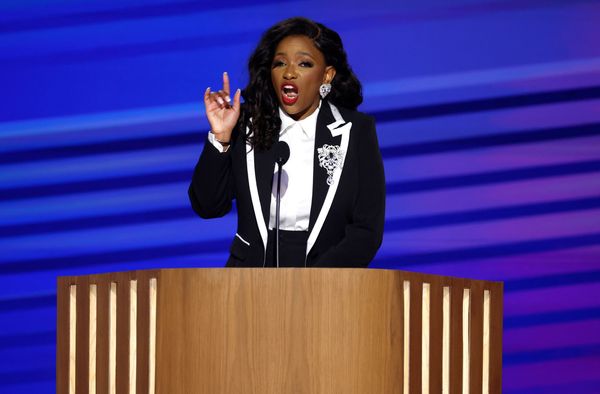
“Jeremy! Jeremy!” Handkerchiefs folded in top pockets, tan jackets and slacks, panama hats with egg-and-bacon straps. “Good to see you! I thought you might be here. Are you sitting up top?” Chateau D’Esclans, 2021, £47.50 a bottle. “No, Marks and Sparks, good, aren’t they?” Candy cane blazers, red chinos, pink cheeks. “But I had had a drink or two.” A formal standard of dress applies in the pavilion on all match days. You can only buy one if you have membership, same with a blazer. Footwear not appropriate to a formal setting includes flip flops, strapless sandals, branded/leisure trainers, canvas shoes, walking shoes/boots and running shoes.
Lord’s, of course, day one of the Test.
It’s 10 minutes’ walk to the cricket pitches in Regent’s Park. There are six of them in the space of a few acres, they’re pressed so close together that if fine leg in one game turns 180 degrees they can shake hands with long off in another. It is one of the best spots for watching cricket in the city. At the weekends there are five or six matches going on at once, a hundred-and-some players from across London and the suburbs, British, Australians, South Africans, Sri Lankans, Indians and Pakistanis playing with and against each other in leagues and friendlies. The chatter here is in English, yes, and also Urdu, Hindi, Tamil, even Afrikaans.
You won’t get a clearer idea of the state of English cricket in one spot than the other, it isn’t either/or, but both, and more. The game contains multitudes. Not that you’d know it from the way it has been portrayed this week. The picture of it painted in some of the media coverage doesn’t capture it so very much better than the bucolic old paintings of the game hanging in the Lord’s pavilion.
English cricket isn’t any one thing, whatever either side tells you. It was English cricket that gave an opportunity to Basil D’Oliveira to escape from apartheid, it was English cricket that then refused to pick him for a tour back to that very same country, most likely because the administrators were worried about offending the South African prime minister, and it was English cricket that found room for him in the squad after all when one of the players selected ahead of him, Tom Cartwright, withdrew because he couldn’t stomach the prospect of playing in South Africa.
It was English cricket that refused to pick Kumar Shri Ranjitsinhji, and it was English cricket that forced the selectors to relent and bring him into the Test team after all. It was English cricket that brought Learie Constantine to this country, and it was English cricket that refused him a county contract because he was black. It was English cricket that banned the rebel tourists for playing in South Africa, and English cricket that rehabilitated them again.

It was an English cricketer, Henry Hyndman, who founded Britain’s first socialist party, and it was an English cricketer, Alec Douglas-Home, who led the Conservatives into the 1964 general election. It was English cricket that picked the Rev David Sheppard, a future Labour peer, in the same team as Ted Dexter, who stood as a candidate for the Tories in that same election. It was English cricket that inspired CLR James to write Beyond A Boundary, it was English cricket that inspired Mike Marqusee to write Anyone But England, and it was English cricket that inspired John Major to write More Than A Game.
William Rees-Mogg reminiscing about going to the county ground at Taunton when he was a boy is English cricket, and so is Harold Pinter reminiscing about bunking off school to sneak to Lord’s to watch Len Hutton bat. Harold Larwood being picked to play Test cricket after leaving school at 13 to work in a miner’s co-operative is English cricket. Lord Tennyson being picked to play Test cricket a year after graduating from Oxford is also English cricket. It was English cricket that made Andrew Strauss, educated at Caldicott, Radley and Durham University, captain, and it was English cricket that made Ben Stokes, who dropped out of Cockermouth School with a single GCSE in PE, captain too.
Eton v Harrow at Lord’s is English cricket, so is British Afghan CC v Dustokhail at Beaulieu Park, and so is Karmand v Kashmir in the Quaid e Azam league. Eoin Morgan was talking about English cricket when he said he felt “Allah was with us” after his team won the World Cup in 2019. It was English cricket that brought 3,000 Bangladesh supporters to Chelmsford last month to watch their team play against Ireland. It is English cricket that has succeeded so brilliantly it has almost a million recreational players from ethnically diverse backgrounds in 2021, and it is English cricket that has failed so dismally it had only 39 professional players from ethnically diverse backgrounds in 2021.
There are serious and significant systemic failings in English cricket, many of them are laid out by the Independent Commission for Equity in Cricket report into the sport. We’ve been reporting on them here in The Guardian for as long as we’ve been covering the game, I’ve spent years writing about them myself. But there is no one correct perspective on it, not our’s or anyone else’s. The sport doesn’t belong to anyone, and its problems can’t and won’t be fixed by one side, or the other, only by everyone together.







